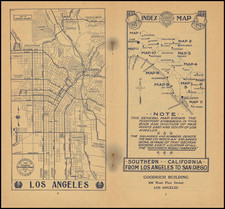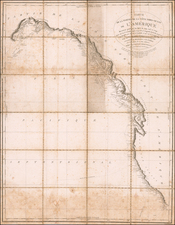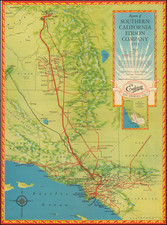Detailed map of the area around Yuma, Arizona prepared by G.S.Crites, Assistant Engineer of the Southern Pacific Railway, in connection with the Yuma Project of the US Bureau of Reclamation, showing transportation lines, levees and a new port of entry from Mexico.
The map depicts the system of levees constructed between 1907-1909 in order to protect the banks of the Colorado River from flooding and its historical course-changing meandering. The Reservation levee was constructed on the west bank of the river between Lagunato and Araz. The Yuma Valley levees were on the east bank of the river until the Colorado-Gila River confluence and then to the Mexican border. To maintain the levees, the Bureau of Reclamation built rail lines on top of the Reservation levee so rail cars could reinforce or fill in problem areas. This proved successful during a major flood in 1912 and the Bureau asked Southern Pacific Railway if another line could be built on the Yuma Valley levee but they were reluctant. With its own acquired funding, the Bureau began to construct the Yuma Valley Railway in May 1914 and despite hot temperatures and wage strikes, construction was completed in February 1915.
The map was prepared during a time period when the US Government and the Southern Pacific Railroad were collaborating in the construction of a series of levees, and displays the existing lines of the Southern Pacific Railroad along the International Border and the Colorado River and the various levees in existence and under construction in the area, to the southwest of the confluence of the Gila River and Colorado River.
Several railroad details are shown, as are the Old Bed of the Colorado River (shown as dry as of January 28, 1911), the Old Slough to Volcano Lake, the C.D. Canal, Alamo River and other details. The New Port of Entry east of the Colorado River between Arizona and Mexico is shown.
The Yuma Project was a U.S. Bureau of Reclamation project built to irrigate over 68,000 acres of land in Yuma County, Arizona and parts of Imperial County, California. The project was designed to exploit year-round farming conditions and water from the Colorado River. It consists of the Laguna Diversion Dam, pumping plants, a power plant, a 53-mile system of canals, 218 miles of lateral canals, levees and drains. The project began in 1903 and the majority of the work was completed by 1915. It was the first dam and reclamation project on the Colorado River and workers had to overcome many natural and logistical obstacles to build and maintain it. The Laguna Diversion Dam was replaced by the Imperial Dam as the Project's water source between 1941 and 1948.
In 1854, the United States purchased the future Yuma Project's land in the Gasden Purchase, but had created the Fort Yuma Indian Reservation in 1884 to settle the indigenous Quechuan Indians. Much of the land was disputed in the 1890s and in 1910, the Dawes Severalty Act opened the land to white settlers which led to further disputes. A series of court battles between the United States and the landholders led to the United States winning a decision and acquiring the land in 1898.
Farmers immediately began constructing gravity-fed irrigation systems in the area which proved inconsistent and ultimately ineffective. In 1902, the Reclamation Act was passed, allotting funds for western farm development and creating the U.S. Bureau of Reclamation.
In 1903, U.S. President Theodore Roosevelt turned the entire Fort Yuma Indian Reservation over to the Bureau of Reclamation for development. Future farmers in the area formed the Yuma County Water Users' Association later in 1903 and in 1904, U.S. Secretary of the Interior Ethan A. Hitchcock authorized the Yuma Project. The project included a series of dams, canals and levees, which were constructed over the next decade.











![[Mission San Luis Rey] Vue de La Mission de Saint Louis Roi De France](https://storage.googleapis.com/raremaps/img/small/71720.jpg)


![[ San Diego County / Julian Mining District ] Sixth Annual Report of the State Mineralogist. Part I for the year ending June 1st 1886.](https://storage.googleapis.com/raremaps/img/small/101709.jpg)